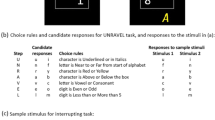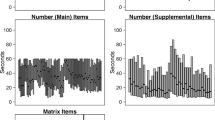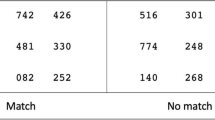Abstract
A ‘mindset’ is a configuration of processing resources that are made available for the task at hand as well as their suitable tuning for carrying it out. Of special interest, remote-relation abstract mindsets are introduced by activities sharing only general control processes with the task. To test the effect of a remote-relation mindset on performance on a Fluid Intelligence test (Raven’s Advanced Progressive Matrices, RAPM), we induced a mindset associated with little usage of executive processing by requiring participants to execute a well-defined classification rule 12 times, a manipulation known from previous work to drastically impair rule-generation performance and associated cognitive processes. In Experiment 1, this manipulation led to a drop in RAPM performance equivalent to 10.1 IQ points. No drop was observed in a General Knowledge task. In Experiment 2, a similar drop in RAPM performance was observed (equivalent to 7.9 and 9.2 IQ points) regardless if participants were pre-informed about the upcoming RAPM test. These results indicate strong (most likely, transient) adverse effects of a remote-relation mindset on test performance. They imply that although the trait of Fluid Intelligence has probably not changed, mindsets can severely distort estimates of this trait.


Similar content being viewed by others
References
Aronson, J., & McGlone, M. S. (2008). Stereotype and social identity threat. In T. Nelson (Ed.), The handbook of prejudice, stereotyping, and discrimination (pp. 153–178). New York, NY: Psychology Press.
Aronson, J., Fried, C. B., & Good, C. (2002). Reducing the effects of stereotype threat on african american college students by shaping theories of intelligence. Journal of Experimental Social Psychology, 38, 113–125. doi:10.1006/jesp.2001.1491.
Ashby, F. G., Alfonso-Reese, L., Turken, A. U., & Waldron, E. M. (1998). A neuropsychological theory of multiple systems in category learning. Psychological Review, 105, 442–481. doi:10.1037/0033-295X.105.3.442.
Ashby, F. G., & Isen, A. M. (1999). A neuropsychological theory of positive affect and its influence on cognition. Psychological Review, 106, 529–550.
Batey, M., Furnham, A., & Safiullina, X. (2010). Intelligence, general knowledge and personality as predictors of creativity. Learning and Individual Differences, 20, 532–535. doi:10.1016/j.lindif.2010.04.008.
Baumeister, R. F., Muraven, M., & Tice, D. M. (2000). Ego depletion: a resource model of volition, self-regulation, and controlled processing. Social Cognition, 18, 130–150. doi:10.1521/soco.2000.18.2.130.
Bors, D. A., & Stokes, T. L. (1998). Raven’s Advanced Progressive Matrices: norms for first-year university students and the development of a short form. Educational and Psychological Measurement, 58, 382–398. doi:10.1177/0013164498058003002.
Brown, R. P., & Day, E. A. (2006). The difference isn’t black and white: stereotype threat and the race gap on Raven’s Advanced Progressive Matrices. Journal of Applied Psychology, 91, 979–985. doi:10.1037/0021-9010.91.4.979.
Carpenter, P. A., Just, M. A., & Shell, P. (1990). What one intelligence test measures: a theoretical account of the processing in the Raven Progressive Matrices test. Psychological Review, 97, 404–431. doi:10.1037/0033-295X.97.3.404.
Cattell, R. B. (1987). Intelligence: its structure, growth and action. Oxford: North-Holland.
Cole, M. W., Yarkoni, T., Repovš, G., Anticevic, A., & Braver, T. S. (2012). Global connectivity of prefrontal cortex predicts cognitive control and intelligence. The Journal of Neuroscience, 32, 8988–8999. doi:10.1523/JNEUROSCI.0536-12.2012.
Colzato, L. S., van der Wel, P., Sellaro, R., & Hommel, B. (2016). A single bout of meditation biases cognitive control but not attentional focusing: evidence from the global–local task. Consciousness and Cognition, 39, 1–7.
Conway, A. R. A., Cowan, N., Bunting, M. F., Therriault, D. J., & Minkoff, S. R. B. (2002). A latent variable analysis of working memory capacity, short-term memory capacity, processing speed, and general fluid intelligence. Intelligence, 30, 163–184. doi:10.1016/S0160-2896(01)00096-4.
Crescentini, C., Seyed-Allaei, S., De Pisapia, N., Jovicich, J., Amati, D., & Shallice, T. (2011). Mechanisms of rule acquisition and rule following in inductive reasoning. The Journal of Neuroscience, 31, 7763–7774. doi:10.1523/JNEUROSCI.4579-10.2011.
Denney, N. W., & Heidrich, S. M. (1990). Training effects on Raven’s Progressive Matrices in young, middle-aged, and elderly adults. Psychology and Aging, 5, 144–145. doi:10.1037/0882-7974.5.1.144.
Dreisbach, G. (2012). Mechanisms of cognitive control the functional role of task rules. Current Directions in Psychological Science, 21, 227–231.
Dreisbach, G., & Goschke, T. (2004). How positive affect modulates cognitive control: reduced perseveration at the cost of increased distractibility. Journal of Experimental Psychology. Learning, Memory, and Cognition, 30, 343–353.
Dreisbach, G., & Haider, H. (2008). That’s what task sets are for: shielding against irrelevant information. Psychological Research, 72, 355–361.
Dreisbach, G., & Haider, H. (2009). How task representations guide attention: further evidence for the shielding function of task sets. Journal of Experimental Psychology. Learning, Memory, and Cognition, 35, 477–486. doi:10.1037/a0014647.
Duckworth, A. L., Quinn, P. D., Lynam, D. R., Loeber, R., & Stouthamer-Loeber, M. (2011). Role of test motivation in intelligence testing. PNAS Proceedings of the National Academy of Sciences of the United States of America, 108, 7716–7720. doi:10.1073/pnas.1018601108.
ErEl, H., & Meiran, N. (2011). Mindset changes lead to drastic impairments in rule finding. Cognition, 119, 149–165. doi:10.1016/j.cognition.2011.01.002.
Fischer, R., & Hommel, B. (2012). Deep thinking increases task-set shielding and reduces shifting flexibility in dual-task performance. Cognition, 123, 303–307. doi:10.1016/j.cognition.2011.11.015.
Förster, J., Friedman, R. S., & Liberman, N. (2004). Temporal construal effects on abstract and concrete thinking: consequences for insight and creative cognition. Journal of Personality and Social Psychology, 87, 177–189. doi:10.1037/0022-3514.87.2.177.
Freitas, A. L., Gollwitzer, P., & Trope, Y. (2004). The influence of abstract and concrete mindsets on anticipating and guiding others’ self-regulatory efforts. Journal of Experimental Social Psychology, 40, 739–752. doi:10.1016/j.jesp.2004.04.003.
Friedman, N. P., Miyake, A., Corley, R. P., Young, S. E., DeFries, J. C., & Hewitt, J. K. (2006). Not all executive functions are related to intelligence. Psychological science, 17, 172–179.
Fujita, K., Gollwitzer, P. M., & Oettingen, G. (2007). Mindsets and pre-conscious open-mindedness to incidental information. Journal of Experimental Social Psychology, 43, 48–61. doi:10.1016/j.jesp.2005.12.004.
Fujita, K., Trope, Y., Liberman, N., & Levin-Sagi, M. (2006). Construal levels and self-control. Journal of Personality and Social Psychology, 90, 351–367. doi:10.1037/0022-3514.90.3.351.
Galinsky, A. D., & Kray, L. J. (2004). From thinking about what might have been to sharing what we know: the effects of counterfactual mind-sets on information sharing in groups. Journal of Experimental Social Psychology, 40, 606–618. doi:10.1016/j.jesp.2003.11.005.
Ginossar, Z., & Trope, Y. (1987). Problem solving in judgment under uncertainty. Journal of Personality and Social Psychology, 52, 464–474. doi:10.1037/0022-3514.52.3.464.
Gollwitzer, P. M. (1990). Action phases and mind-sets. In E. T. Higgins & R. M. Sorrentino (Eds.), Handbook of motivation and cognition (pp. 53–92). New York: Guilford Press.
Gollwitzer, P. M. (2012). Mindset theory of action phases. In P. Van Lange, A. W. Kruglanski, & E. T. Higgins (Eds.), Handbook of theories of social psychology (pp. 526–545). London: Sage.
Goschke, T. (2003). Voluntary action and cognitive control from a cognitive neuroscience perspective. In S. Maasen, W. Prinz, & G. Roth (Eds.), Voluntary action. An issue at the interface of nature and culture (pp. 49–85). Oxford, England: Oxford University Press.
Grange, J. A., & Houghton, G. (Eds.). (2014). Task switching and cognitive control. New York: Oxford University Press.
Heitz, R. P., Unsworth, N., & Engle, R. W. (2005). Working memory capacity, attention control, and fluid intelligence. In O. Wilhelm R. W. Engle (Ed.), Understanding and measuring intelligence (pp. 61–77). New York, NY: Sage Publications, Inc. doi:10.4135/9781452233529.n5.
Hommel, B. (2015). Between persistence and flexibility: The yin and yang of action control. In A. J. Elliot (Ed.), Advances in motivation science (pp. 33-67). New York: Elsevier. doi:10.1016/bs.adms.2015.04.003.
Inzlicht, M., & Schmader, T. (2011). Stereotype threat: Theory, process, and application. New York: Oxford University Press.
Irwing, P., Cammock, T., & Lynn, R. (2001). Some evidence for the existence of a general factor of semantic memory and its components. Personality and Individual Differences, 30, 857–871. doi:10.1016/S0191-8869(00)00078-7.
Jeffreys, H. (Ed.). (1939/1961). The theory of probability (1st/3rd ed.) Oxford, England: Clarendon Press.
Jimura, K., Locke, H. S., & Braver, T. S. (2010). Prefrontal cortex mediation of cognitive enhancement in rewarding motivational contexts. PNAS Proceedings of the National Academy of Sciences of the United States of America, 107, 8871–8876. doi:10.1073/pnas.1002007107.
Kool, W., & Botvinick, M. (2014). A labor/leisure tradeoff in cognitive control. Journal of Experimental Psychology: General, 143, 131–141.
Kool, W., McGuire, J. T., Rosen, Z. B., & Botvinick, M. M. (2010). Decision making and the avoidance of cognitive demand. Journal of Experimental Psychology: General, 139, 665–682. doi:10.1037/a0020198.
Kounios, J., Frymiare, J. L., Bowden, E. M., Fleck, J. I., Subramaniam, K., Parrish, T. B., & Jung-Beeman, M. (2006). The prepared mind: neural activity prior to problem presentation predicts subsequent solution by sudden insight. Psychological Science, 17, 882–890. doi:10.1111/j.1467-9280.2006.01798.x.
Love, J., Selker, R., Marsman, M., Jamil, T., Verhagen, A. J., Ly, A.,… Wagenmakers, E. J. (2015). JASP (version 0.6.6) [computer software]. Retrieved from https://jasp-stats.org.
Luchins, A. S. (1942). Mechanization in problem solving: The effect of einstellung. Psychological Monographs, 54, i-95. doi:10.1037/h0093502.
Marshalek, B., Lohman, D. F., & Snow, R. E. (1983). The complexity continuum in the radex and hierarchical models of intelligence. Intelligence, 7, 107–127
Markman, K. D., Lindberg, M. J., Kray, L. J., & Galinsky, A. D. (2007). Implications of counterfactual structure for creative generation and analytical problem solving. Personality and Social Psychology Bulletin, 33, 312–324. doi:10.1177/0146167206296106.
McGuire, J. T., & Botvinick, M. M. (2010). Prefrontal cortex, cognitive control, and the registration of decision costs. Proceedings of the National Academy of Sciences of the United States of America, 107, 7922–7926. doi:10.1073/pnas.0910662107.
Nguyen, H. D., & Ryan, A. M. (2008). Does stereotype threat affect test performance of minorities and women? A meta-analysis of experimental evidence. Journal of Applied Psychology, 93, 1314–1334. doi:10.1037/a0012702.
Nisbett, R. E., Aronson, J., Blair, C., Dickens, W., Flynn, J., Halpern, D. F., & Turkheimer, E. (2012a). Group differences in IQ are best understood as environmental in origin. American Psychologist, 67, 503–504. doi:10.1037/a0029772.
Nisbett, R. E., Aronson, J., Blair, C., Dickens, W., Flynn, J., Halpern, D. F., & Turkheimer, E. (2012b). Intelligence: new findings and theoretical developments. American Psychologist, 67, 130–159. doi:10.1037/a0026699.
Rasmussen, D., & Eliasmith, C. (2011). A neural model of rule generation in inductive reasoning. Topics in Cognitive Science, 3, 140–153. doi:10.1111/j.1756-8765.2010.01127.x.
Raven, J. C., & Court, J. H. (1998). Raven’s Progressive Matrices and Vocabulary scales Oxford. England: Oxford Psychologists Press.
Reisenauer, R., & Dreisbach, G. (2013). The impact of task rules on distracter processing: automatic categorization of irrelevant stimuli. Psychological Research, 77, 128–138.
Schmader, T. (2002). Gender identification moderates stereotype threat effects on women’s math performance. Journal of Experimental Social Psychology, 38, 194–201. doi:10.1006/jesp.2001.1500.
Shenhav, A., Botvinick, M., & Cohen, J. (2013). The expected value of control: an integrative theory of anterior cingulate cortex function. Neuron, 79, 217–240. doi:10.1016/j.neuron.2013.07.007.
Smith, P. K., Jostmann, N. B., Galinsky, A. D., & van Dijk, W. W. (2008). Lacking power impairs executive functions. Psychological Science, 19, 441–447. doi:10.1111/j.1467-9280.2008.02107.x.
Sprenger, J. (2013). Testing a precise null hypothesis: the case of Lindley’s paradox. Philosophy of Science, 80, 733–744. doi:10.1086/673730.
Steele, C. M. (1998). A threat in the air: How stereotypes shape intellectual identity and performance. In J. L. Eberhardt S. & T. Fiske (Eds.), Confronting racism: The problem and the response (pp. 202-233). Thousand Oaks, CA: Sage Publications, Inc.
Steele, C. M., & Aronson, J. (1995). Stereotype threat and the intellectual test performance of african americans. Journal of Personality and Social Psychology, 69, 797–811. doi:10.1037/0022-3514.69.5.797.
Steenbergen, L., Sellaro, R., Hommel, B., & Colzato, L. S. (2015). Tyrosine promotes cognitive flexibility: evidence from proactive vs. reactive control during task switching performance. Neuropsychologia, 69, 50–55. doi:10.1016/j.neuropsychologia.2015.01.022.
Verguts, T., & de Boeck, P. (2002). The induction of solution rules in Raven’s Progressive Matrices test. European Journal of Cognitive Psychology, 14, 521–547. doi:10.1080/09541440143000230.
Verguts, T., De Boeck, P., & Maris, E. (1999). Generation speed in Raven’s Progressive Matrices test. Intelligence, 27, 329–345. doi:10.1016/S0160-2896(99)00023-9.
Author information
Authors and Affiliations
Corresponding author
Ethics declarations
Ethics approval
The experiments presented in this study were approved by the Ethics Committees of the IDC and by the Ethics Committees of Netanya Academic College. Informed consent was obtained from all individual participants included in the study.
All procedures performed in studies involving human participants were in accordance with the ethical standards of the institutional and/or national research committee and with the 1964 Helsinki declaration and its later amendments or comparable ethical standards.
We wish to thank two anonymous reviewers for valuable comments and Dganit Avioz, Viki Abramov and Bat-El Elbaz for their help in data collection.
Rights and permissions
About this article
Cite this article
ErEl, H., Meiran, N. A drop in performance on a fluid intelligence test due to instructed-rule mindset. Psychological Research 81, 901–909 (2017). https://doi.org/10.1007/s00426-016-0796-8
Received:
Accepted:
Published:
Issue Date:
DOI: https://doi.org/10.1007/s00426-016-0796-8




